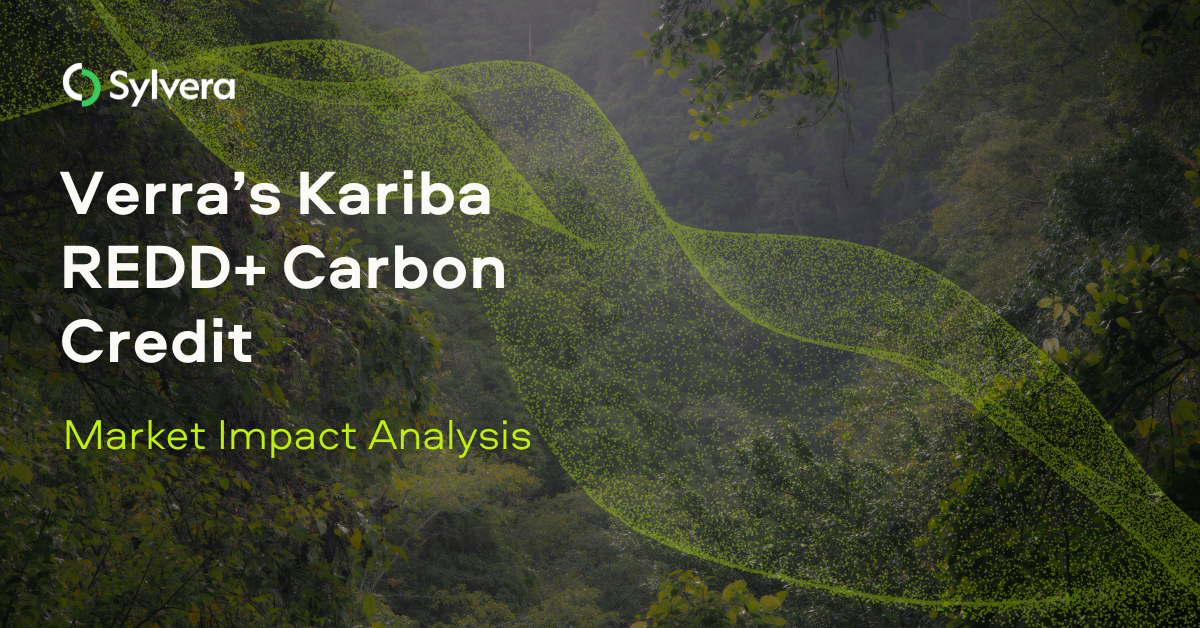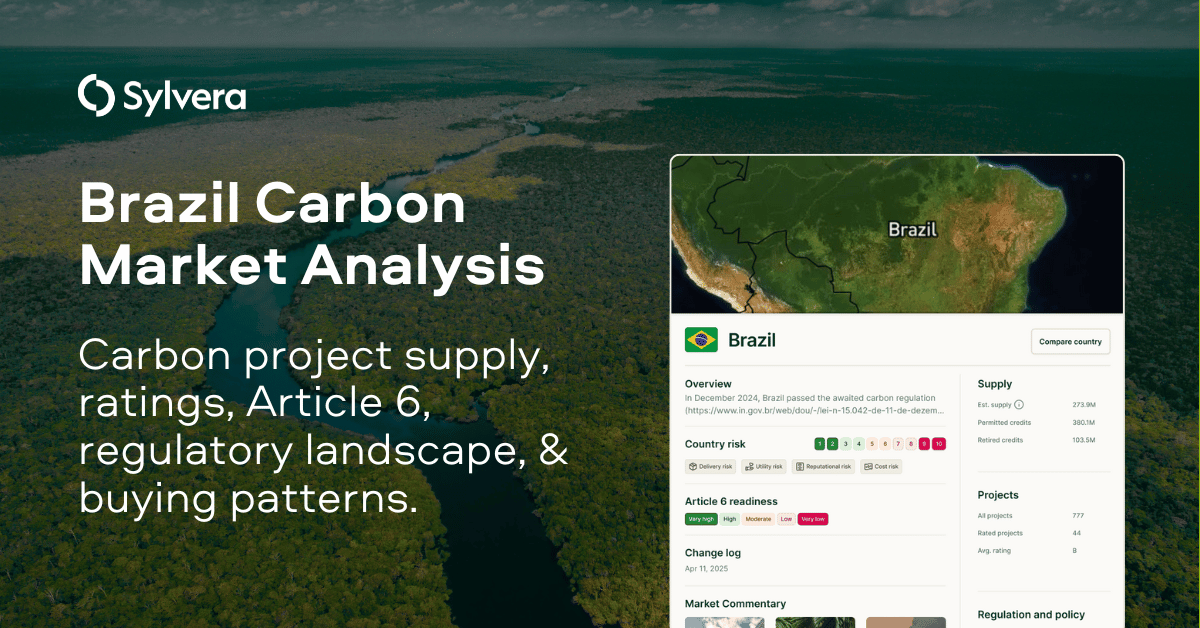「私たちは長年にわたり、信頼できる格付けの提供に注力し、現地データチームへの投資を重ねてきました。これにより当社の格付けの正確性は確保されていますが、購入者が検討している数千のプロジェクトにわたるスケールを実現することはできません。」
カーボンクレジット調達の最新動向について詳しくは、当社の記事「Key Takeaways for 2025」をご覧ください。調達戦略を改善するための、データに基づく5つのヒントをご紹介しています。

加えて:Connect to Supplyをご利用のお客様は、Sylveraのその他のツールもご利用いただけます。プロジェクトの格付け確認や強みの評価、高品質なカーボンクレジットの調達に加え、プロジェクトの進捗状況のモニタリング(特に発行前段階で投資している場合)も可能です。
Sylveraの無料デモを予約して、調達機能やレポーティング機能を体験しましょう。
Kariba Carbon Credits: What This Means for the Carbon Market
Understanding the Active Credit Exposure
While the headline figure of 15.2 million excess credits is substantial, the practical market impact is more contained than it may appear:
- Only 4.9 million credits (18% of total issued) remain active and unretired. Verra is engaging with holders of these credits to request voluntary cancellation.
- The remaining 10.3 million credits have already been retired for offsetting claims and will maintain their status as valid retirements in Verra's registry.
- An additional 10.1 million verified-but-unissued credits have been permanently removed, though these were unlikely to enter the market given the project's 2023 suspension and subsequent withdrawal.
- In a response, South Pole has taken proactive action to request that Verra cancel the 2.5 million credits held by the company, however it is unclear whether these have already been retired or not.

Precedent-Setting Implications for Carbon Credit Quality
This Verra carbon credit cancellation decision raises critical questions about registry accountability and market-wide precedent:
- Compensation Mechanisms: It remains unclear what practical "compensation" Verra will seek for the 10.3 million already-retired credits. Whether this will be financial restitution or nominal acknowledgment will significantly impact how registries handle future over-issuance cases.
- VM0009 Portfolio Risk: Verra previously indicated it would seek corrections if VM0048 jurisdictional baselines prove lower than VM0009 project-level baselines. The Kariba decision may signal Verra's willingness to pursue retroactive adjustments across the VM0009 portfolio.
- Broader Methodology Review: As all Avoided Unplanned Deforestation (AUD) methodologies transition to VM0048, this precedent could extend beyond VM0009 to other project-level baseline approaches, particularly where significant baseline discrepancies exist.
Carbon Market Evolution and REDD+ Project Quality
The carbon accounting methodology that generated these discrepancies—VM0009—has been discontinued, and the market has evolved significantly:
- Modern REDD+ projects utilize jurisdictional baselines aligned with national forest monitoring data, reducing projection-based risks
- Due diligence standards have intensified across the market, with buyers demanding higher levels of independent verification
- Leading project developers are proactively adopting robust methodologies, transparent governance structures, and third-party verification to differentiate high-quality projects in an increasingly sophisticated market
- The case demonstrates why independent ratings and ongoing monitoring are essential components of carbon market integrity
What This Means for Carbon Credit Buyers
Carbon credit buyers and Sylvera customers should evaluate:
- Active Kariba Holdings: The ~4.9 million active credits face voluntary cancellation requests. Holders must weigh reputational considerations against the validity status Verra has maintained for these credits.
- Retired Kariba Credits: Previously retired credits remain valid in the Verra registry. However, stakeholders may question their environmental integrity despite their maintained status.
- Broader VM0009 Exposure: Organizations holding credits from other VM0009 projects should assess whether similar baseline discrepancies could emerge, particularly for projects with high projected deforestation rates relative to jurisdictional data.
Carbon Credit Risk Mitigation Strategies
- Methodology Diversification in Carbon Offsetting: Prioritize REDD+ projects using jurisdictional baselines (VM0048) or newer methodologies with reduced baseline projection risk
- Enhanced Carbon Credit Due Diligence: Leverage independent carbon credit ratings that compare project-level baselines against jurisdictional deforestation data and satellite observations
- Proactive Carbon Project Monitoring: Implement ongoing carbon project monitoring rather than one-time due diligence, as baseline accuracy can only be assessed over time
Strategic Positioning in the Carbon Market
The Kariba REDD+ case validates the importance of independent carbon verification that goes beyond registry certification:
- Sylvera's 2021 carbon credit analysis (subscription required) pre-identified the over-crediting issues that Verra's review has now confirmed
- Comparative baseline analysis in REDD+ projects—assessing project projections against observed deforestation data—is essential for identifying high-risk carbon credits
- Carbon stock verification using remote sensing provides additional validation of carbon credit quality. Transparent data source disclosure is crucial for comparative analysis. Verra has not disclosed the data sources for its analysis, which would facilitate such comparisons. Sylvera's approach involved a Synthetic Aperture Radar-based deforestation detection method and carbon stock estimates calibrated by Multi-Scale LiDAR field measurements. For further information, please refer to our research.

Looking Forward: Carbon Market Integrity and REDD+ Quality
Verra's decision to review the Kariba project and subsequently cancel credits represents a welcome development for the market. Nevertheless, the underlying data and methodologies employed in this review have been available to market participants for several years, as evinced by Sylvera's prior analysis. The issuance and retirement of credits within the market since that time diminish the efficacy of Verra's retroactive intervention.
To cultivate transparency and confidence, it is imperative that feedback cycles between crediting registries and independent third-party auditors (comprising ratings agencies, academic institutions, and regulatory bodies) be accelerated. This acceleration would facilitate the timely and substantive implementation of corrective actions moving forward.
This development represents a significant step in market accountability, though the practical impacts are more nuanced than headline figures suggest. The case underscores the critical importance of:
- Independent, science-based project assessment beyond registry certification
- Jurisdictional baseline approaches that reduce projection-based risks
- Ongoing monitoring systems that validate credit quality over project lifetimes
- Transparent registry processes for addressing quality issues when they emerge
Sylvera continues to provide independent analysis that helps market participants navigate these complexities with confidence, using transparent methodologies that assess both carbon accounting integrity and safeguard implementation. Contact us for an independent rating or get a demo of our comprehensive carbon data platform.

















